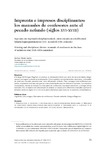Imprenta e impresos disciplinantes: los manuales de confesores ante el pecado nefando (siglos XVI-XVIII)

Use este enlace para citar
http://hdl.handle.net/2183/33795
Excepto si se señala otra cosa, la licencia del ítem se describe como Atribución-NoComercial-SinDerivadas 4.0 Internacional
Colecciones
- Investigación (FFIL) [877]
Metadatos
Mostrar el registro completo del ítemTítulo
Imprenta e impresos disciplinantes: los manuales de confesores ante el pecado nefando (siglos XVI-XVIII)Título(s) alternativo(s)
Inprenta eta inprimaki diziplinatzaileak: aitor-entzuleen eskuliburuak bekatu higuingarriarentzat (xvi. mendetik xviii.erakoak)Printing and disciplinary forms: manuals of confessors in the face of nefarious sin (16th-18th centuries)
Autor(es)
Fecha
2022Cita bibliográfica
Ruiz Astiz, J. 2022. Imprenta e impresos disciplinantes: los manuales de confesores ante el pecado nefando (siglos xvi-xviii). Huarte de San Juan. Geografía e Historia. 29 (jun. 2022), 51–72. DOI:https://doi.org/10.48035/rhsj-gh.29.3.
Resumen
[Español] A lo largo del Antiguo Régimen se produjo un destacado interés por parte de las autoridades religiosas por conseguir controlar la moral popular. Entre aquellos comportamientos desviados, sobresalen las prácticas sexuales pecaminosas, caso del pecado nefando. Para conseguir este ambicioso propósito, emplearon distintas vías gracias a las posibilidades que les ofrecía la imprenta. Los impresos moralizantes, donde se incluían los manuales de confesores, buscaban adoctrinar y corregir dichas actitudes. Así, el objetivo de este estudio es realizar un repaso a los diferentes manuales que fueron editados entre los siglos XVI y XVIII en la península ibérica para censurar la sodomía y el bestialismo. [Euskera] Antzinako Erregimenean, agintari erlijiosoei interes berezia piztu zitzaien jendearen morala kontrolatzeko. Jokabide desbideratuetan nabarmenenak bekatuzko praktika sexualak ziren, hala nola bekatu higuingarria. Helburu anbiziotsu hori erdiesteko, bide bat baino gehiago erabili zituzten inprentak eskaintzen zizkien aukerez baliatuz. Horietako bat inprimaki diziplinatzaileak ziren, besteak beste aitor-entzuleen eskuliburuak, jendea doktrinatzeko eta jokabide bekatuzkoak zuzentzeko balio zutenak. Ikerlan honen xedea da sodomia eta bestialismoa zentsuratzearren XVI. mendetik XVIII.era Iberiar penintsulan argitaratu ziren eskuliburuak berrikustea. [Inglés] During the Old Regime, there was a prominent interest on the part of the religious authorities to control popular morality. Among those deviant behaviors, sinful sexual practices stand out, such as nefarious sin. To achieve this ambitious purpose they used different ways thanks to the possibilities offered by the printing press. The moralizing printed matter, where the confessors manuals were included, sought to indoctrinate and correct these attitudes. Thus, the objective of this study is to review the different manuals that were published between the 16th and 18th centuries in the Iberian Peninsula to censor sodomy and bestiality.
Palabras clave
Imprenta
Libro antiguo
Manual de confesores
Pecado nefando
Antiguo Régimen
Inprenta
Antzinako liburuak
Aitorentzuleen eskuliburuak
Bekatu higuingarria
Antzinako Erregimena
Printing
Old book
Confessors’ manuals
Nefarious sin
Old Regime
Libro antiguo
Manual de confesores
Pecado nefando
Antiguo Régimen
Inprenta
Antzinako liburuak
Aitorentzuleen eskuliburuak
Bekatu higuingarria
Antzinako Erregimena
Printing
Old book
Confessors’ manuals
Nefarious sin
Old Regime
Versión del editor
Derechos
Atribución-NoComercial-SinDerivadas 4.0 Internacional
ISSN
2341-0809






